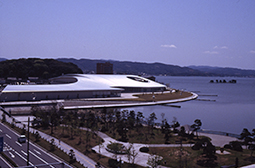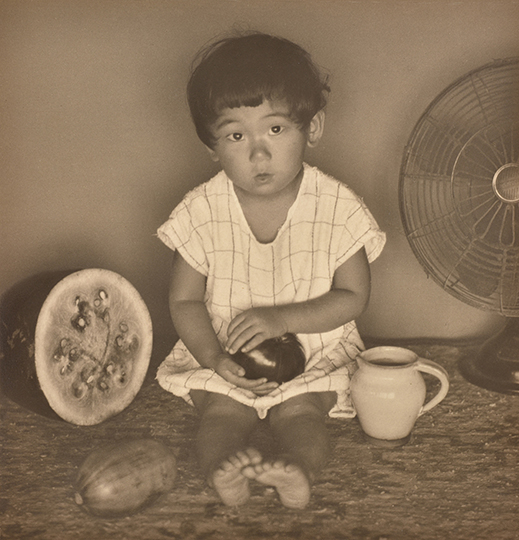 |
Focus features two in-depth reviews each month of fine art, architecture and design exhibitions and events at art museums, galleries and alternative spaces around Japan. The contributors are non-Japanese residents of Japan. |
|
|
 |
 |
 |
Pictorial Photographer of San'in: Teiko Shiotani at the Shimane Art Museum
Alice Gordenker |
 |
"Bird's-eye View of a Village" (1925). Gelatin silver print. |
How is it that one of the most influential Japanese photographers of the early 20th century is also one of the least known? Teiko Shiotani (1899-1988) devoted his life to photography, producing hauntingly beautiful images of the landscapes and people of his native San'in region, an area of Western Japan that faces the Japan Sea and comprises Tottori and Shimane Prefectures. Yet even in his homeland few people today are familiar with his work. Fortunately, a grand-scale exhibition is now bringing an unprecedented number of Shiotani's photographs to a modern audience. Based on entirely new research on more than 1,000 images, including many newly released by the artist's family, the exhibition and accompanying catalog should go a long way in restoring him to his rightful place in photographic history.
To Things Beloved: SHIOTANI Teiko 1899-1988, the largest-ever retrospective of Shiotani's work, runs through 8 May at the Shimane Art Museum in Matsue, Shimane Prefecture. It features more than 300 prints, the vast majority of which have never before been shown publicly, as well as over 100 related exhibits, including many of the original art photography magazines in which his images were first published.
 |
|
 |
|
The Shimane Art Museum, a public facility that opened in 1999, is beautifully situated on the shores of a lake in the center of town, and is perhaps best known for the spectacular sunset views that can be enjoyed from the panoramic windows in the lobby. But it would be a shame if visitors overlooked the museum's collection, which is built around several themes, including photography, paintings that feature water, and Japanese prints.
"View of the Seashore" (1926). Gelatin silver print. |
Shiotani was born in Tottori Prefecture as the oldest son of a well-to-do shipping agent. He received his first camera from his father in 1912, while still a boy, and at a time when hobby photography was still unusual in Japan. The camera was the small and lightweight Kodak "Vest Pocket," and although it was considered entry-level equipment, Shiotani continued to use it throughout his career to produce any number of masterpieces. Like many users in Japan, he preferred to shoot without the metal hood intended to shield the lens, deliberately admitting more light into the lens to achieve a soft focus.
By 18, Shiotani had established a local club for art photography that attracted members from all over the region. He had his first photograph published in a magazine in 1925, and with "Bird's Eye View of a Village" won top prize in the inaugural issue of Asahi Camera (January 1926). He was soon recognized as a top contender for the many prizes offered by photography magazines, and at least 200 of his works were published in magazines during the 1920s and '30s.
 |
|
"Girl with Still Life" (1932). Gelatin silver print. Private collection, entrusted to the Shimane Art Museum. The child is his oldest daughter, Kyoko. |
Shiotani originally considered becoming a painter, and was deeply influenced by the international pictorialism movement in which photographers sought to "create" an image rather than simply record it. He and others in Japan experimented with different ways to manipulate and enhance what would otherwise be a straightforward photograph, deliberately using distortion or painting in details by hand to better express an inner vision. One of Shiotani's most famous images is "Landscape with Forecasted Weather," which pictures a stone jetty that can be seen from the second floor of his family home. To accentuate the roughness of the sea that day, Shiotani bent the paper as he was developing the print, greatly exaggerating the curve of the horizon.
"Landscape with Forecasted Weather" (1931). Gelatin silver print. |
Shiotani was particularly skilled in a uniquely Japanese technique called zokin-gake. This is often translated as "rag-wipe retouching," but the process is far more involved than that wording suggests. Artists would spread a thin layer of an oil-based pigment over the entire surface of a print and then partially remove it by rubbing judiciously with a piece of cloth. Shiotani went a step further, using carefully blended oil paints, or candle soot that he collected himself, to paint in details such as doorways and mountains in the background that may not have existed in the actual scene. Shiotani employed this method throughout his career, and in nearly his entire oeuvre, to create the dreamy, painting-like quality that characterizes his work. Stories were legion about how he might spend hours, or even days, finishing a single print.
"View of Matsue" (1929). Gelatin silver print. |
Shiotani's artistry and success attracted others around him to photography, and Tottori soon boasted a disproportionately high concentration of camera buffs. In 1927, for example, the prefecture ranked fifth in the nation in the number of residents who were members of photography clubs. This largely agricultural region, with no major cities, was outranked only by the urban areas of Tokyo, Osaka, Kobe and Kyoto. Through such photography clubs, and his publication in magazines, Shiotani encouraged a great number of aspiring photographers, including Shoji Ueda, who went on to become a major figure in 20th-century Japanese photography. Ueda, also a Tottori native and 13 years Shiotani's junior, once wrote that Shiotani was a "god-like figure" to him.
Self-portrait of Teiko Shiotani (1934). Gelatin silver print. |
So given his influence and fame during the 1920s and '30s, how is it that Shiotani later all but disappeared into obscurity? One reason is that fashions change and Shiotani chose not to change with them. As in Europe and the United States, pictorialism fell out of favor in Japan around the middle of the 1930s, giving way to modernist influences that formed the basis of what came to be called "new photography" (shinko shashin). Although Shiotani dabbled briefly in these new ideas, he soon returned to expressionism and continued to work quietly in his own style, living all his life in Tottori Prefecture and sticking with subjects close to home.
After the war, Ueda, who considered himself an inheritor of Shiotani's expressionist style, strove to reestablish his mentor's reputation and encouraged the publication of collections of Shiotani's works, in 1975 and 1984. In 1982, some of Shiotani's photographs were shown in Germany, where they were well received. But the Shiotani family kept most of his work, and for many years, there were few opportunities for collectors to see or acquire a Shiotani photograph. The present exhibition was made possible by a major gift in 2014, in which the family donated over 700 prints to the Shimane Art Museum, making it the largest depository in the world of Shiotani's work.
This opportunity to see so many Shiotani photographs in one go is more than enough reason to make the trip to Matsue, a charming city that also boasts one of Japan's few remaining Edo-era castles in original form, and a rare black one at that. But to sweeten the deal for those with a particular interest in Japanese photography, the museum has two special exhibitions running concurrently with the Shiotani show: Ikko Narahara's images of Venice, and Daido Moriyama's views of Paris. Foreign visitors can get discounted admission to the museum and other attractions in Matsue by showing their passport or residence card.
All images courtesy of the Shimane Art Museum. Unless otherwise noted, works pictured are from the museum's collection. |
 |
| To Things Beloved: SHIOTANI Teiko 1899-1988 |
| 6 March - 8 May 2017 |
| Shimane Art Museum |
Hours: 10 a.m. to 30 minutes after sundown (a daily sunset schedule is posted on the museum website). Closed on Mondays except when Monday falls on a national holiday (in which case the museum is closed the following day) and 29 December - 1 January.
Access: The museum can be reached on foot from JR Matsue Station -- a pleasant 15-minute walk, mostly along the lake shore -- or via bus #82 (Minami Junkan-sen Uchimawari route) from bus stand #1 at the north exit of the station; ride six minutes to the Kenritsu Bijutsukan-mae stop. There is frequent train service to Matsue from Tokyo, Osaka and Okayama. The closest airport for flights from Tokyo and Osaka is Yonago Kitaro Airport in adjacent Tottori Prefecture. A Kuko Renraku (airport connector) bus makes the trip to JR Matsue Station in about 45 minutes. |
|
 |
 |
Alice Gordenker
Alice Gordenker is a writer and translator based in Tokyo, where she has lived for more than 17 years. For over a decade, she penned the "So, What the Heck Is That?" column for The Japan Times, providing in-depth reports on everything from industrial safety to traditional talismans. She translates and consults for museums, and has a special interest in making Japanese museums more accessible for visitors from other countries. |
|
 |
|